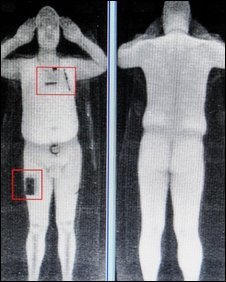英國曼徹斯特機場近日引入了一套X光人體掃描安檢設備,以幫助安檢人員迅速發現乘客身上藏匿的武器或爆炸物,同時省去了傳統手檢時需要脫衣、脫鞋的繁冗程序。因為這套全身掃描設備可以清晰照射出人體的“裸體”輪廓,隱私部位均顯露無疑,所以有些乘客不愿意接受這樣的檢查。該機場客服部門負責人表示,這種設備得到的圖像只顯示在一個遙控的終端上,并且只有一名安檢人員能看到,掃描的圖像無法保存或抓取,在安檢通過后即被刪除。另外,這種設備的輻射水平很低,人們一年接受5000次照射也不用擔心會受到傷害。據悉,這套設備價值8萬英鎊,英國希斯羅機場也曾在2004年試用過。
Full body scanner trialed at Manchester Airport


 |
|
An X-ray machine which produces ''naked'' images of passengers has been introduced at Manchester Airport, enabling staff to instantly spot any hidden weapons or explosives. |
An X-ray machine which produces "naked" images of passengers has been introduced at Manchester Airport, enabling staff to instantly spot any hidden weapons or explosives.
The full body scanner, which is being trialed, will also show up any breast enlargements, false limbs, piercings, and a clear outline of passengers' private parts.
Some travelers might not want to be scanned because of the graphic nature of the images, bosses admit.
They can refuse to undergo the virtual strip search at Terminal 2, opting for the traditional "pat down" search instead.
But the black and white image will only be seen by one officer in a remote location before it is deleted, Sarah Barrett, head of customer experience at the airport, said.
"Most of our customers do not like the traditional 'pat down' search, they find it too intrusive, but they still want to be kept safe.
"This scanner completely takes away the hassle of needing to undress. The images are not erotic or pornographic and they cannot be stored or captured in anyway," she said.
The scanner, made by the firm RapiScan Systems, makes the check-in process much quicker for passengers, who will not have to remove their coats, shoes or belts.
Frequent fliers do not need to worry about radiation from the low-level X-ray, she said, and a dental X-ray transmits 20,000 times more radiation.
"Passengers can go through this machine 5,000 times a year each without worrying, it is super safe and the amount of radiation transmitted is tiny," Ms Barrett said.
The scanners, which cost £80,000 each, were also trialed at Heathrow Airport in 2004. The Department for Transport will decide whether to install them permanently at the end of the trial, which is expected to last for a year.
Electromagnetic waves are beamed on to passengers while they stand in a booth, and a virtual three-dimensional "naked" image is created from the reflected energy.
Security officials in the United States have pioneered their use at New York and Los Angeles airports, and they are gradually being rolled out in other airports in the country.
相關閱讀
(Agencies)